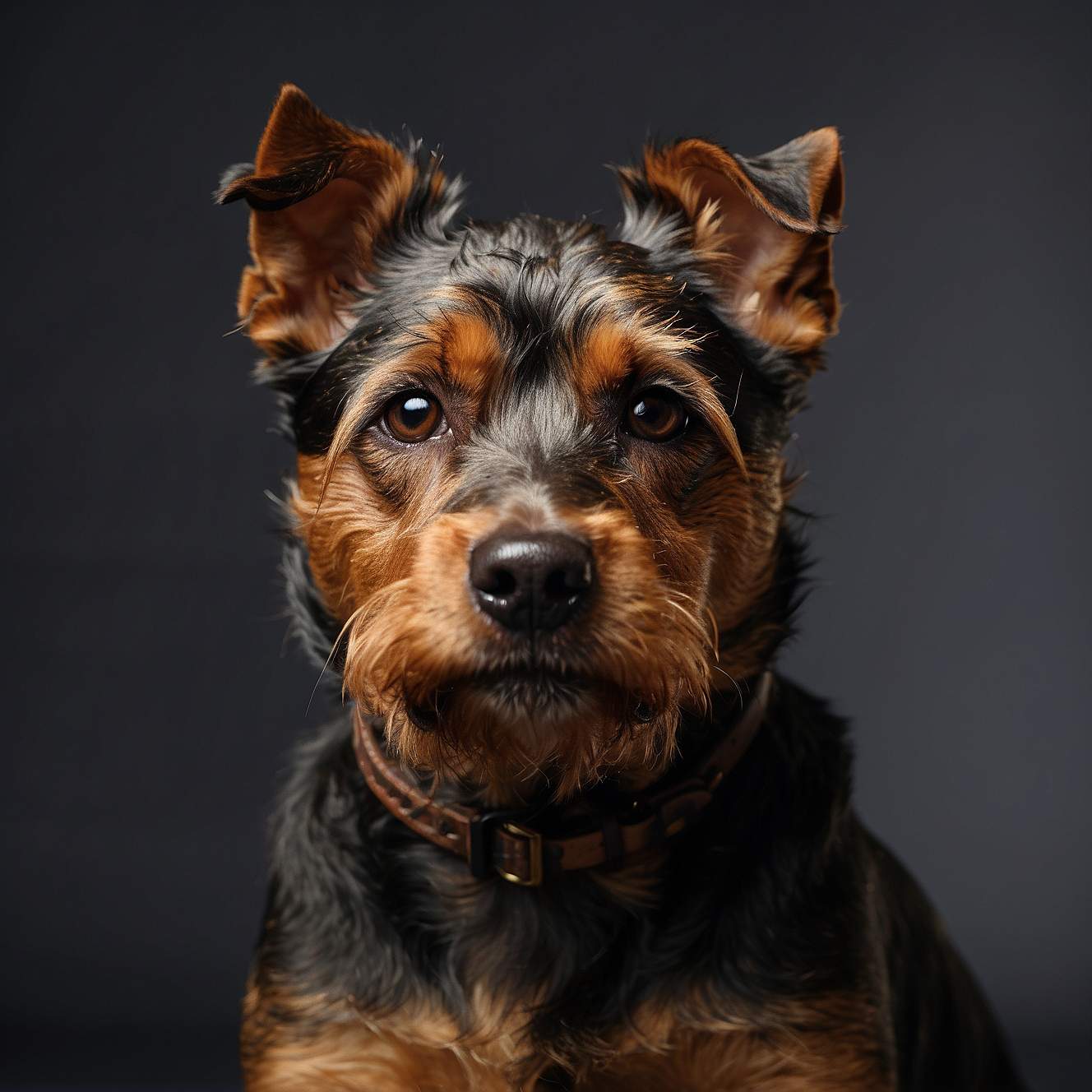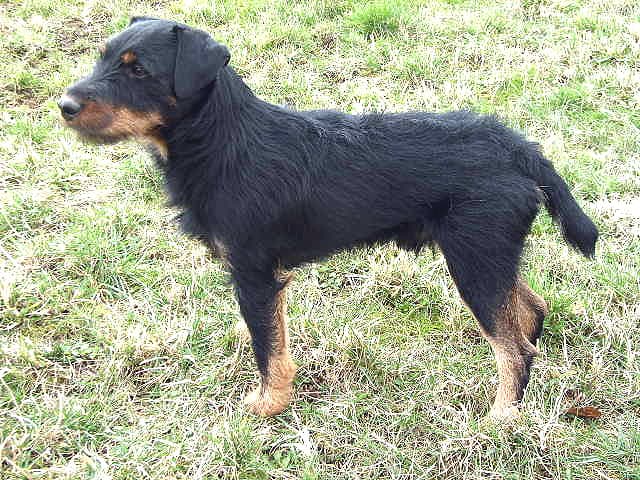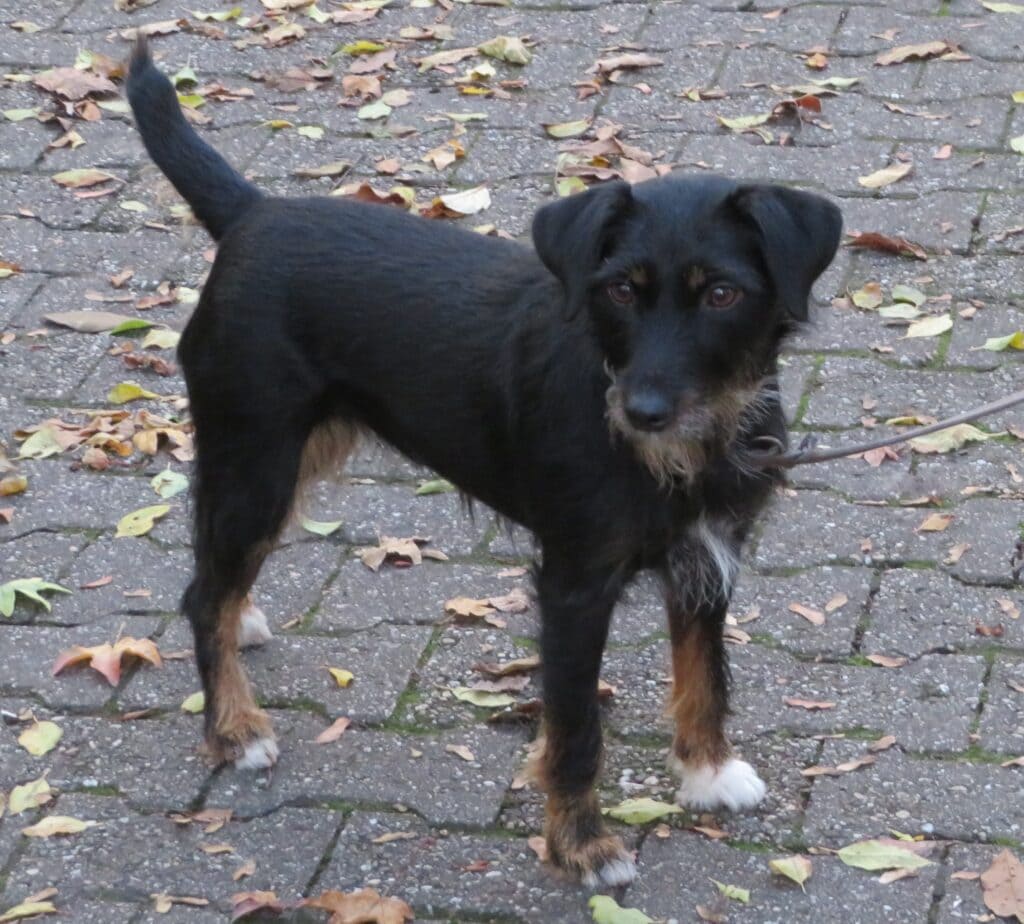The Jagdterrier, a versatile and skilled hunting terrier, is celebrated for its tenacity and determination in the field. Originating from Germany, this breed is adept at tracking, retrieving, and dispatching game. With its compact frame and strong work ethic, the Jagdterrier is a valued companion for hunters and outdoor enthusiasts, displaying both courage and loyalty in its pursuit of tasks and adventures.

| Category (Explanation) | Breed Information |
|---|---|
| Year of Breed Conception | Early 20th century |
| Country of Origin | Germany |
| Weight (lbs & kg) (Male) | 17-22 lbs (7.5-10 kg) |
| Weight (lbs & kg) (Female) | 15-20 lbs (7-9 kg) |
| Coat Type | Short, dense coat |
| Color Variations | Black and tan |
| Shedding Level (Low, Moderate, High) | Low |
| Height (cm & in) | 13-16 inches (33-41 cm) |
| Breed Size | Small to medium |
| Trainability (Low, Moderate, High) | High |
| Mental Needs (Low, Moderate, High) | Moderate |
| Intelligence Level (Low, Moderate, High) | High |
| Energy Level (Low, Moderate, High) | High |
| Agility (Low, Moderate, High) | High |
| Loyalty (Low, Moderate, High) | High |
| Playfulness (Low, Moderate, High) | High |
| Exercise Needs | Regular exercise and mental stimulation |
| Guarding Proficiency (Low, Moderate, High) | High |
| Sociability with Children (Low, Moderate, High) | Moderate |
| Barking Level (Low, Moderate, High) | Moderate |
| Digging Tendency (Low, Moderate, High) | Moderate |
| Destructive Behavior (Low, Moderate, High) | Moderate |
| Drooling Level (Low, Moderate, High) | Low |
| Obedience Level (Low, Moderate, High) | High |
| Apartment Friendly (Yes/No) | Can adapt to apartment living with sufficient exercise |
| Inherent Prey Drive | High |
| Physical Risk to Others (Low, Moderate, High) | Low |
| Travel Fatality Risk (Low, Moderate, High) | Low |
| Allergen Potential | Low |
| Health Concerns (List of Common Health Concerns) | Hip Dysplasia, Patellar Luxation, Ear Infections |
| Average Life Expectancy (Life Expectancy in Years) | 10-15 years |
Woof Mastery is reader supported and our articles may contain affiliate links.
Instead of running third party ads that we have no control of we only use links from high-quality companies we are directly partnered with. Making use of these links come at no cost to you our reader, and in many cases have the extra benefit of discounted rates or sign up bonuses.
If you’re interested you can read more about our affiliate policy here.
We appreciate your support and always insure that the products and services we recommend are high-quality, helpful and relevant to the subject at hand!
The Jagdterrier, originating in Germany, has a history deeply connected to hunting. Bred in the 20th century, this terrier was developed by crossing various terriers and working dogs. The goal was to create a versatile hunting companion capable of tracking, flushing, and retrieving game. The Jagdterrier’s tenacity, intelligence, and agility made it a valuable asset for hunters, especially those pursuing game in challenging terrains. Today, this breed continues to excel in hunting and has gained recognition for its prowess in various dog sports.

The Jagdterrier is exceptional for its versatility and skill in hunting. Bred for tracking, flushing, and retrieving game, this terrier embodies determination and tenacity in the field. Its intelligence and agility make it a standout hunting companion. What makes it special is its unwavering focus on the task at hand and its ability to excel in challenging terrains. The Jagdterrier’s strong work ethic and resilience contribute to its special status as a dedicated and capable hunting partner.
The Jagdterrier’s traditional role is deeply connected to hunting in Germany. Developed in the 20th century, this terrier was specifically bred for versatility in tracking, flushing, and retrieving game. Its intelligence, agility, and tenacity made it a valuable hunting companion, especially in challenging terrains. The Jagdterrier’s traditional role persists today as an exceptional hunting dog, continuing to demonstrate its skills in various hunting activities and competitions, showcasing its enduring legacy as a versatile and determined working terrier.
Jagdterriers are known for their versatility and determination. Bred for hunting, they exhibit focus and tenacity in the field. These terriers are intelligent and energetic, making them excellent hunting companions. While they can be reserved with strangers, they form strong bonds with their owners. Jagdterriers require mental and physical stimulation to thrive. With the right training and an active lifestyle, they can be loyal and devoted family members, showcasing a work ethic and spirit that reflects their history as skilled hunting terriers.
Jagdterriers are known for their determined and focused temperament, particularly in hunting activities. Their intelligence and energy levels require mental and physical stimulation. While they can form strong bonds with their families, they may exhibit reserved behavior around strangers. Proper training is essential to manage their tenacity. Jagdterriers may not always get along with other dogs, especially those of the same sex, necessitating careful introductions. Their history as hunting terriers underscores the importance of early socialization. With consistent training and an active lifestyle, Jagdterriers can showcase a well-balanced temperament, combining loyalty with a strong work ethic.
Jagdterriers are medium-sized dogs with a strong and athletic build. They have a well-proportioned head, a slightly tapered muzzle, and a distinct stop. Their eyes are small, dark, and alert, and their ears are set high and fold forward. The breed has a dense, harsh coat that can be black and tan, dark brown, or gray. Jagdterriers have a straight back, a deep chest, and a high-set tail. They convey a sense of determination and agility, reflecting their history as hunting terriers.
Jagdterriers come in various color variations, adding to their versatile and adaptable appearance. The most common color variations for Jagdterriers include:
Jagdterriers commonly exhibit brindle coat patterns, characterized by dark stripes on a lighter background. The brindle pattern is often seen in black and tan variations. While other coat patterns may occur, the brindle pattern is a classic and recognizable feature of the breed. The dense, harsh coat provides protection during hunting activities. The breed’s coat pattern, combined with its athletic build, reflects its history as a hunting terrier.
Jagdterriers have a low to moderate shedding level. Their dense, harsh coat sheds minimally, and regular grooming is important to manage shedding and maintain coat health. Brushing the coat once or twice a week helps remove loose fur and prevents matting. While Jagdterriers are not heavy shedders, grooming practices are essential to ensure their coat remains in good condition.
Jagdterriers, being a working terrier breed, have a short, dense coat that requires regular grooming to keep them clean and healthy. Grooming habits for Jagdterriers include:
Brushing: Regular brushing with a firm bristle brush or a grooming mitt helps remove loose hair and prevents matting. This should be done about once or twice a week.
Bathing: Jagdterriers generally do not require frequent baths. Bathing as needed, using a mild dog shampoo, is sufficient to keep their coat clean.
Ears: Regularly check and clean their ears to prevent wax buildup or infections. Use a damp cotton ball or a veterinarian-recommended ear cleaning solution.
Nails: Keep their nails trimmed to a comfortable length to avoid discomfort and maintain proper foot health.
Teeth: Brush their teeth regularly with a dog-friendly toothbrush and toothpaste to prevent dental issues. Dental chews or toys can also contribute to oral health.
Eye Care: Monitor their eyes for signs of irritation or discharge. If needed, use a damp cloth to clean around the eye area.
Jagdterriers have a high activity level. These hunting terriers are energetic and require ample exercise to fulfill their needs. Daily walks, playtime, and activities that allow them to use their natural instincts are essential. Jagdterriers benefit from mental stimulation through training sessions and puzzle toys. Providing a structured routine that includes both physical and mental engagement is crucial for their well-being.
Jagdterriers are known for their high intelligence, especially in the context of hunting and fieldwork. Their ability to problem-solve and adapt to changing situations makes them versatile working dogs. Training these dogs requires consistency and clear communication. Providing tasks that engage their natural instincts contributes to their overall mental well-being.
Jagdterriers are highly intelligent and benefit from mental stimulation. Engage them in activities like puzzle toys, interactive games, and training sessions to keep their minds active and prevent boredom.
Social Interaction: They are social dogs and need regular interaction with their family. Loneliness can lead to anxiety, so provide companionship and attention.
Exercise: Regular physical activity is crucial for their mental and physical well-being. Engage them in activities that challenge their bodies and minds.
Enter The Woof Mastery

Before welcoming a Jagdterrier into your home, consider the following:
Jagdterriers are highly active and may exhibit exuberant behavior. Early socialization and consistent training are crucial to manage their energy levels and prevent any potential risks. Owners should focus on positive reinforcement techniques to ensure they respond well to commands and are comfortable around others.
Jagdterriers, being highly active, may enjoy playtime with older children. Supervision is important due to their energy levels. Early socialization and obedience training are crucial to ensure they are well-behaved around children. Their alert nature may make them watchful over the family, and proper training can help channel their energy positively in interactions with kids.
Jagdterriers, with their energetic and adventurous nature, may enjoy swimming. However, as with any dog, introduce them to water gradually and ensure they are comfortable. Always supervise them in or around water, and use a canine life vest in situations where additional safety is needed.
Remember that Jagdterrier puppies, like all puppies, are eager to please and learn. Positive and consistent training practices will help them become well-behaved, obedient, and happy adult dogs. Building a strong and trusting bond with your puppy through training is a rewarding experience for both you and your canine companion.
Jagdterriers, being a hunting breed, may have a tendency to bark when they are excited or engaged in activities. Proper training is essential to manage their energy and prevent excessive barking. Early socialization can also contribute to balanced behavior.
Jagdterriers thrive in homes with active owners who can meet their exercise needs. They are adaptable to various living conditions, including apartments, but regular outdoor activities are essential. Socialization is important to prevent aggressive behavior. Positive reinforcement training is effective in shaping their behavior.
Jagdterriers, being active dogs, may require special considerations during travel. Ensure that they have sufficient space in a travel crate and are securely restrained to prevent distractions. Plan for breaks during the journey to allow them to stretch, hydrate, and relieve themselves. Address any anxiety by creating a comfortable travel environment with familiar items. If flying, follow airline regulations for crate size and safety standards for traveling with dogs.
Jagdterriers may be prone to specific health concerns. While not all individuals will experience these issues, it’s crucial for Jagdterrier owners to be aware of potential health problems and collaborate with veterinarians to maintain their pets’ well-being. Common health concerns in Jagdterriers include:
Regular veterinary check-ups, a balanced diet, dental care, and responsible breeding practices can contribute to the overall well-being of Jagdterriers. Owners should be proactive in monitoring their pets’ health and seeking veterinary attention if any concerns arise.
Proper nutrition is crucial for the health and well-being of Jagdterriers. Here are some nutritional habits and best practices to consider for this breed:
Breed-Specific Laws (BSL): Jagdterriers may be subject to breed-specific laws (BSL) in certain areas. These laws are often enacted at the local or municipal level and can vary widely from one jurisdiction to another.
Types of Restrictions: The specific restrictions imposed on Jagdterriers under BSL can include mandatory spaying/neutering, special licensing, liability insurance requirements, muzzling in public, and, in some cases, bans on ownership. The severity of these restrictions depends on local regulations.
Rationale for BSL: BSL is typically implemented based on concerns about public safety and perceived risks associated with specific breeds, often due to incidents involving dog attacks. While Jagdterriers are not inherently aggressive, they can be affected by BSL due to their physical resemblance to breeds that are sometimes included in these laws.
Controversy: It’s important to note that BSL is a controversial topic. Critics argue that it unfairly targets breeds rather than addressing individual dog behavior and that responsible ownership and training should be emphasized instead of breed-specific restrictions.
Local Regulations: To determine if there are breed-specific laws or restrictions regarding Jagdterriers in your area, you should check with your local animal control or government authorities. Be aware of and comply with any local regulations to ensure that you are in compliance with the law while owning a Jagdterrier.
Woof Mastery is reader supported and our articles may contain affiliate links.
Instead of running third party ads that we have no control of we only use links from high-quality companies we are directly partnered with. Making use of these links come at no cost to you our reader, and in many cases have the extra benefit of discounted rates or sign up bonuses.
If you’re interested you can read more about our affiliate policy here.
We appreciate your support and always insure that the products and services we recommend are high-quality, helpful and relevant to the subject at hand!
Myth 1: Jagdterriers are Aggressive
Myth 2: They are Only Suitable for Hunting
Myth 3: Jagdterriers are Difficult to Train
Myth 4: They Require Excessive Exercise
Myth 5: They are Not Good with Children
Myth 6: They are All the Same
Myth 7: Jagdterriers are Not Affectionate
Myth 8: They are High-Maintenance
Myth 9: Jagdterriers are Always Hyperactive
Myth 10: They are Not Good for Novice Owners
These myths emphasize the importance of understanding individual dog behavior and providing proper training and socialization for Jagdterriers to thrive as well-behaved and happy companions.
Famous Jagdterrier examples are not as widely documented, but these versatile and skilled hunting dogs can be found in homes where their hunting abilities are utilized and appreciated.
The Jagdterrier holds cultural significance as a versatile and skilled hunting dog. Originating in Germany, Jagdterriers are recognized for their tenacity and intelligence in various hunting activities. Their role in working environments, as well as their loyal and energetic nature, contributes to their cultural importance. Jagdterriers are symbols of agility and determination, finding appreciation among those who value their hunting capabilities and companionship.
The Jagdterrier holds cultural significance as a versatile and skilled hunting dog. Originating in Germany, Jagdterriers are recognized for their tenacity and intelligence in various hunting activities. Their role in working environments, as well as their loyal and energetic nature, contributes to their cultural importance. Jagdterriers are symbols of agility and determination, finding appreciation among those who value their hunting capabilities and companionship.
Jagdterriers, like many working and hunting breeds, have faced specific challenges over the years. Some notable challenges include:
The Jagdterrier, also known as the German Hunt Terrier, is a German breed developed for hunting. Contributing breeds may include:
Jagdterriers are dynamic and tenacious working dogs that bring a robust and determined spirit to families. Known for their hunting prowess and versatility, they thrive in environments that provide mental and physical challenges. Their loyalty and courage make them excellent companions for individuals or families engaged in outdoor activities. Understanding and catering to their need for stimulation and exercise fosters a strong bond, allowing them to showcase their intelligence and playful side in the home environment.